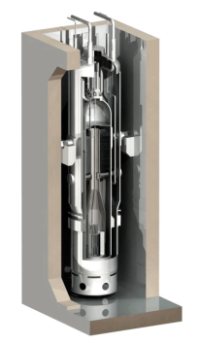The US Department of Energy (DoE) is to help push forward the manufacture of small modular nuclear reactors through new cost-sharing arrangements with private industry to support design and licensing activities.
 |
| Cutaway of NuScale's containment vessel and integrated reactor system (Image: NuScale Power) |
The DoE intends ultimately to fund up to two designs for small modular reactors (SMRs) through a cost-shared partnership which will support first-of-a-kind engineering, design certification and licensing. To that end, it has issued a draft Funding Opportunity Announcement (FOA) to solicit inputs from industry in advance of the full FOA, aiming at a deployment date for the reactors of 2022.
Small, compact reactors of around 300 MWe in capacity - around a third of the size of a typical commercial nuclear power plant - can potentially offer a range of strengths in terms of safety, construction and siting as well as potential economic benefits. Their modular 'plug and play' nature means that they could be made in factories and transported to generation sites, offering economies of scale and reducing both capital costs and construction times. Their small size makes them suitable for small electric grids and locations that cannot support large reactors, while offering the flexibility to install units individually or as modules in a larger generating complex, adding more modules incrementally as required. As well as using a simpler reactor design, SMRs can incorporate a high level of passive or inherent safety in the event of malfunction.
US Energy Secretary Steven Chu described the funding as a "significant step" in designing, manufacturing, and exporting small modular reactors.
"America's choice is clear - we can either develop the next generation of clean energy technologies, which will help create thousands of new jobs and export opportunities here in America, or we can wait for other countries to take the lead."
Steven Chu
US Energy Secretary
Several US companies are involved in the design of SMRs, with development at various stages of advancement. Westinghouse, which is developing its own 200 MWe SMR, has already pledged to take advantage of the DoE's offer. Westinghouse chief technology officer and senior vice president of research and technology Kate Jackson said the company would be applying for the federal funds with a consortium of utilities. "Access to this investment fund helps lower the barrier to market entry for American companies," she said, noting that "virtually all energy sources that feed the national grid" had been developed through public-private research and development partnerships. Indeed, the design certification by the US Nuclear Regulatory Commission of Westinghouse's AP1000 nuclear reactor design, granted in December 2011, was supported through a cost-shared agreement with DoE.
Other US SMR designs at an advanced stage of development include NuScale Power Inc's 45 MWe NuScale reactor, which is envisaged as being clustered in modules of 12 to form a power plant of around 540 MWe, and Babcock & Wilcox's 160 MWe mPower. The NRC is currently involved in pre-application activities on both designs in anticipation of a design certification application for the NuScale reactor in the first months of 2012, followed by one for the mPower design towards the end of 2013.
Researched and written
by World Nuclear News

_615x160.jpg)



_18570.jpg)
_16159.jpg)
_18938.jpg)
_33584.jpg)





